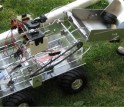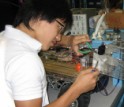News Release 07-120
Can a Robot Get High School Students Interested in Studying Science and Engineering in College?
A team from the University of Pennsylvania has found the answer is 'yes,' if the students design and build the robot themselves

Examples of students' robots, ready for action on the obstacle course.
September 11, 2007
This material is available primarily for archival purposes. Telephone numbers or other contact information may be out of date; please see current contact information at media contacts.
In a paper presented last week at the American Society of Mechanical Engineers conference in Las Vegas, researchers from the University of Pennsylvania outlined an effective way of getting students interested and excited about science and engineering--teaching them how to design, build and operate robots. This approach is a departure from traditional science and engineering education methods, and it suggests a new way of getting students attracted to these fields early in their academic lives.
Over the past three summers, the University of Pennsylvania’s Department of Mechanical Engineering and Applied Mechanics has developed and taught a three-week robotics summer course as part of the School of Engineering and Applied Science’s Summer Academy of Applied Science and Technology (SAAST)The robotics camp, which was developed with funding by the National Science Foundation (NSF), attracted more than 20 students from across the world and from as far away as Turkey, China and the United Kingdom to Philadelphia.
NSF Principal Investigator Professor Vijay Kumar, doctoral students David J. Cappelleri and James F. Keller, and technical staff Terry Kientz and Peter Szczesniak designed an intensive program for the students that immediately got them into a robotics lab to learn what robots are capable of and how to build them. Throughout the three weeks, the students heard lectures from leading robotics experts and toured factories that use advanced robots. The students were also divided into teams and spent time each day designing and building their own robots.
Because robots are complex systems that integrate several different fields, including computer science, mechanical engineering and electronics, they are a good example of applied science and engineering. They can also be exciting and fun to build and operate. Robot design competitions are being used at the high school and undergraduate levels to help students understand how these fields can be used to produce real-world applications.
This top-down approach to science and engineering education is the reverse of how these fields are usually introduced to students. The authors note that typically students must go through years of learning theoretical concepts in mathematics, physics, and other fields before they are allowed to think about putting these concepts into practice. Many students, the authors believe, lose interest in these fields because they must wait so long before experiencing the excitement and creativity that comes from finding solutions to intriguing challenges.
To solve this problem, the authors state in the paper that they set out to create an approach to teaching science and engineering where "students are introduced first to the applications and systems concepts which then leads to the teaching of fundamentals."
At the end of the camp, the teams' robots competed against each other by navigating an obstacle course that tested how well the robots could maneuver and pick up and store various objects such as plastic eggs and hockey pucks. The competition not only gave the students the opportunity to put what they had learned into action, but also taught them how to work as a group to solve complicated challenges that have many possible solutions.
The authors say that some of the participants from the first camp are now studying engineering in college, including three former participants who are enrolled at Penn.
"This approach to teaching forces us, as educators, to develop lectures and homework exercises tailored to capstone projects as opposed to creating projects that support lectures in the classroom," Kumar said.
-NSF-
-
View Video
The SAAST student teams' robots go through a challenging obstacle course. (no audio)
Credit and Larger Version -
Students had three weeks to learn enough about robotics to design and build their own.
Credit and Larger Version
Media Contacts
Dana W. Cruikshank, NSF, (703) 292-8070, email: dcruiksh@nsf.gov
Program Contacts
C.S. George Lee, NSF, (703) 292-8930, email: csglee@nsf.gov
Co-Investigators
Vijay Kumar, GRASP Laboratory, University of Pennsylvania, (215) 898-5814, email: kumar@grasp.upenn.edu
Related Websites
NSF's Division of Information & Intelligent Systems (IIS): http://www.nsf.gov/div/index.jsp?div=IIS
General Robotics, Automation, Sensing and Perception (GRASP) Lab at the University of Pennsylvania: http://www.grasp.upenn.edu/index.html
The U.S. National Science Foundation propels the nation forward by advancing fundamental research in all fields of science and engineering. NSF supports research and people by providing facilities, instruments and funding to support their ingenuity and sustain the U.S. as a global leader in research and innovation. With a fiscal year 2023 budget of $9.5 billion, NSF funds reach all 50 states through grants to nearly 2,000 colleges, universities and institutions. Each year, NSF receives more than 40,000 competitive proposals and makes about 11,000 new awards. Those awards include support for cooperative research with industry, Arctic and Antarctic research and operations, and U.S. participation in international scientific efforts.
Connect with us online
NSF website: nsf.gov
NSF News: nsf.gov/news
For News Media: nsf.gov/news/newsroom
Statistics: nsf.gov/statistics/
Awards database: nsf.gov/awardsearch/
Follow us on social
Twitter: twitter.com/NSF
Facebook: facebook.com/US.NSF
Instagram: instagram.com/nsfgov


